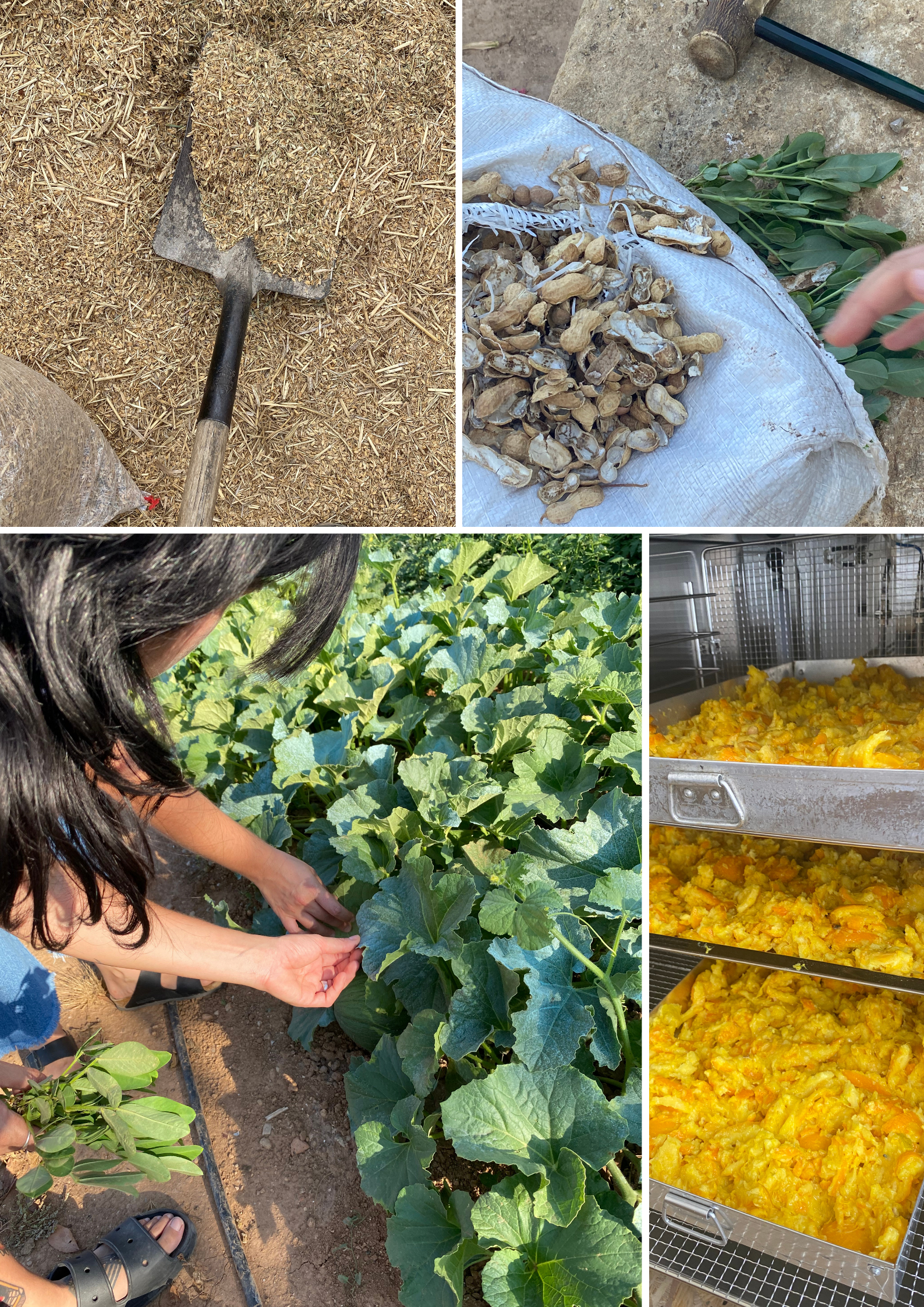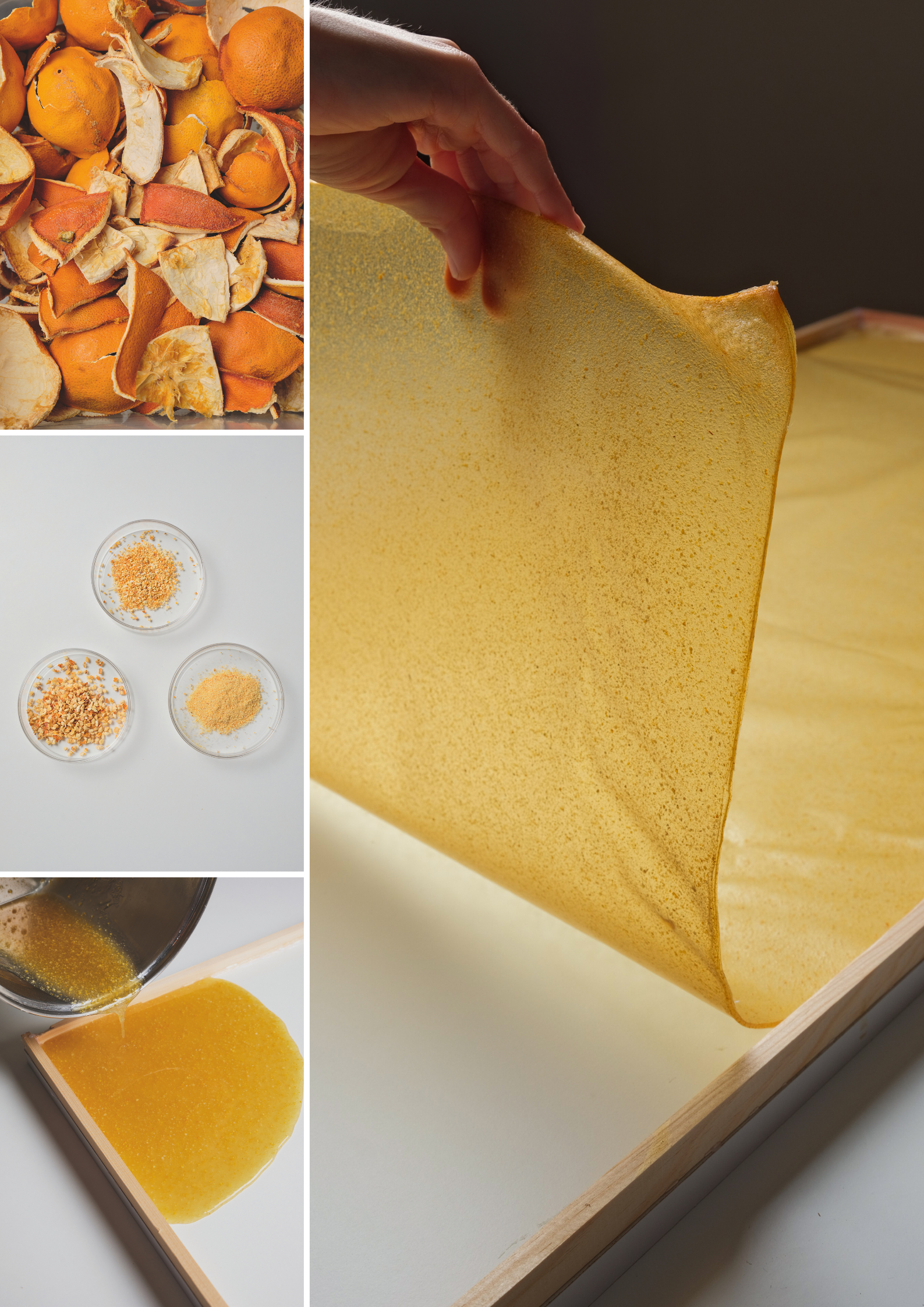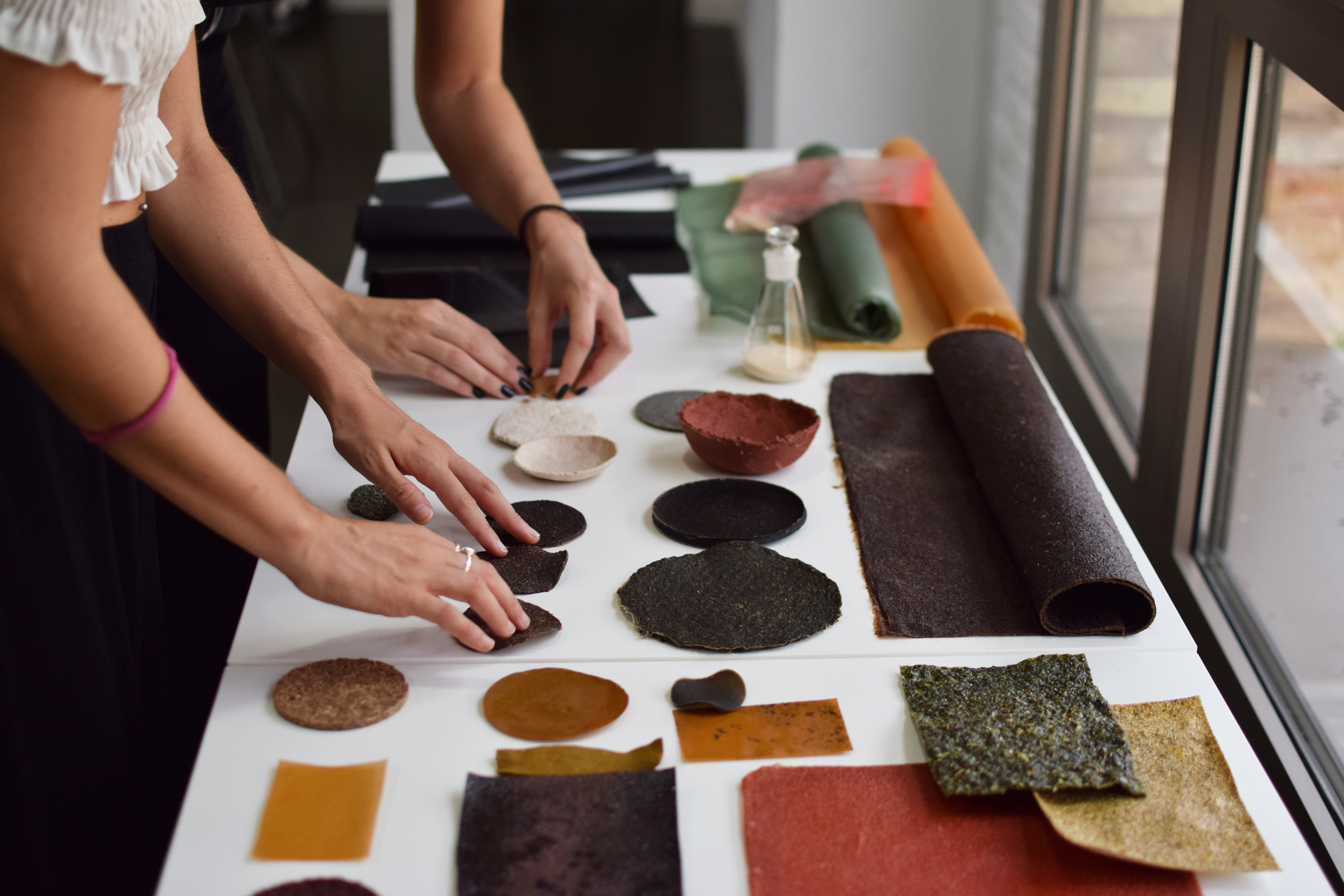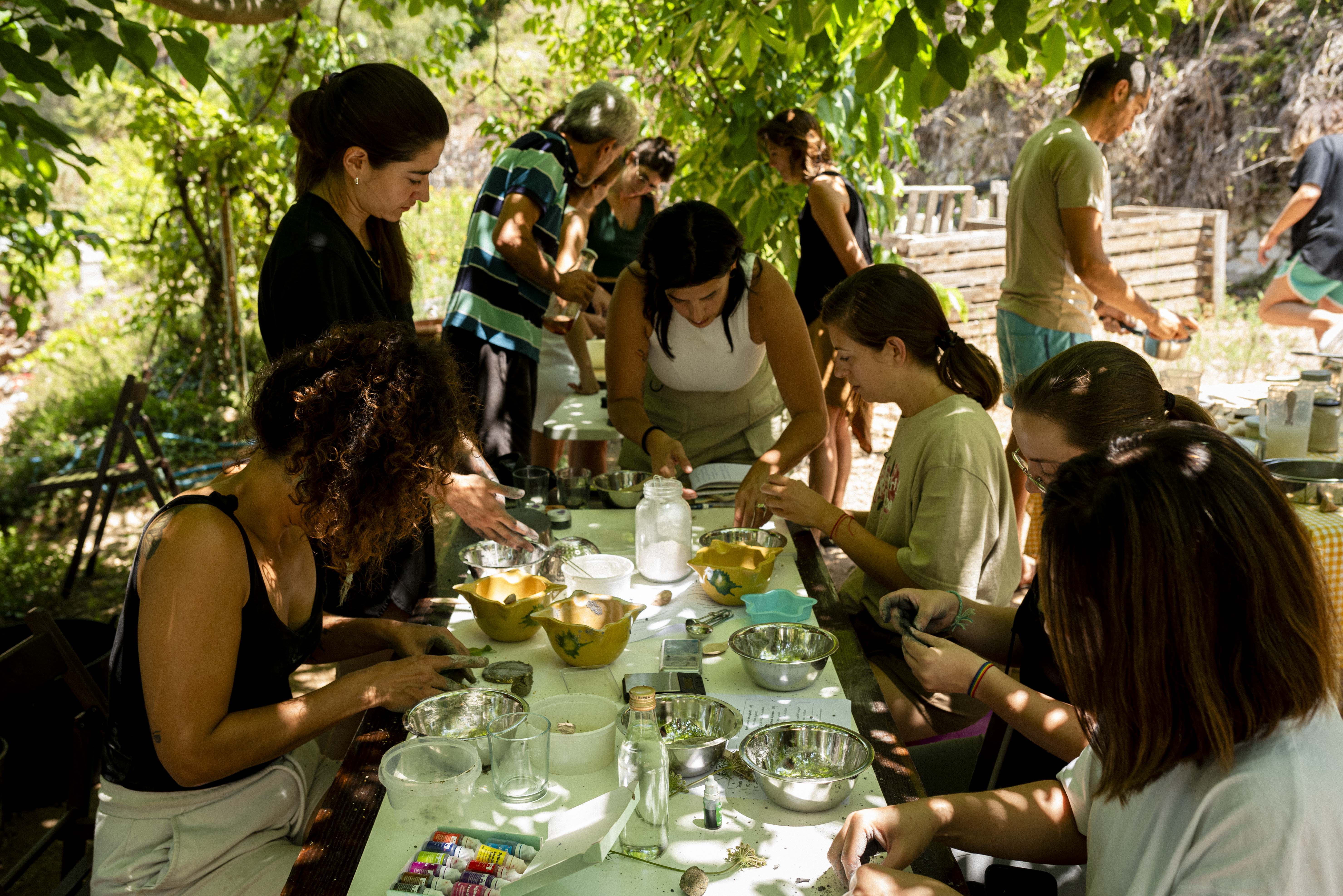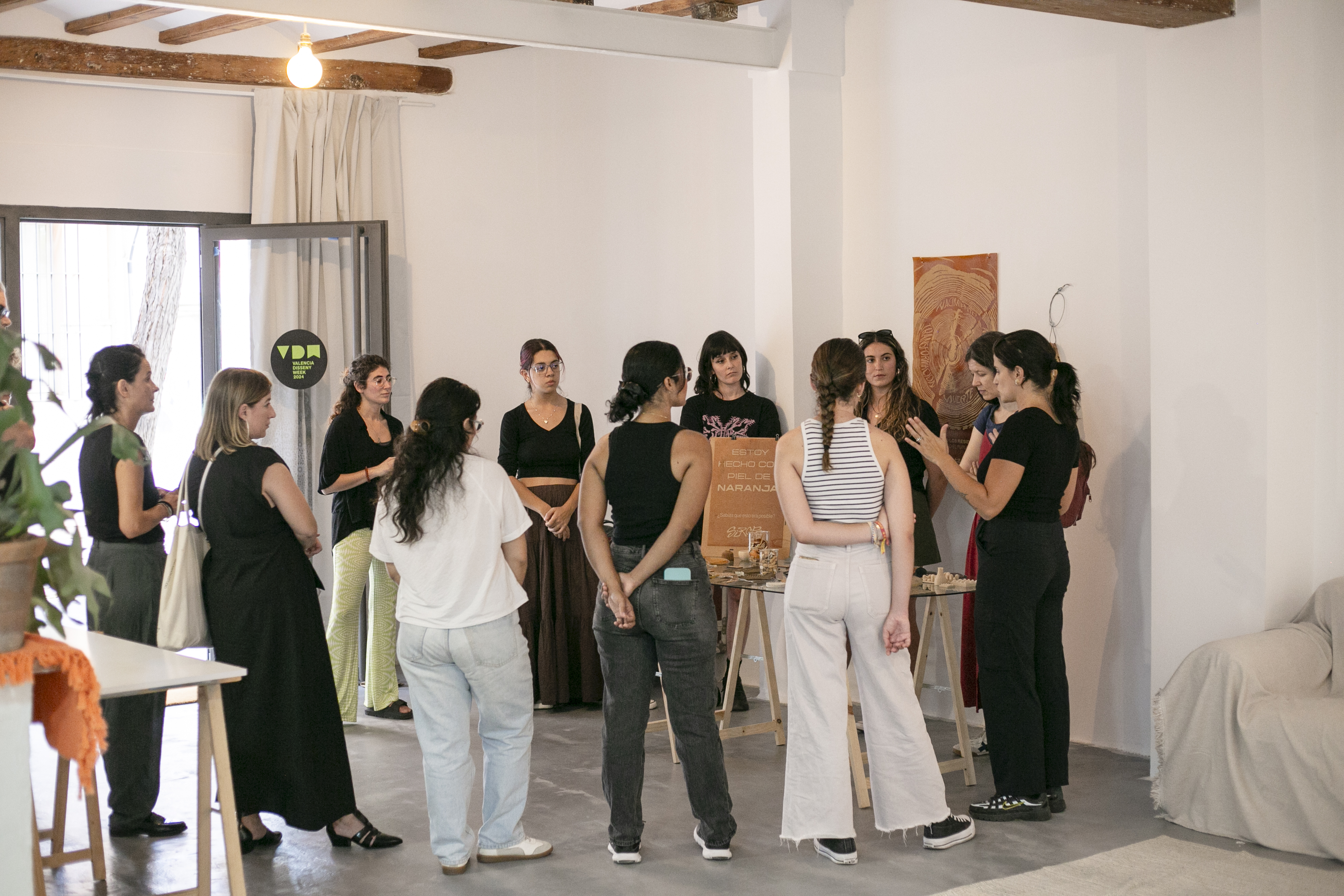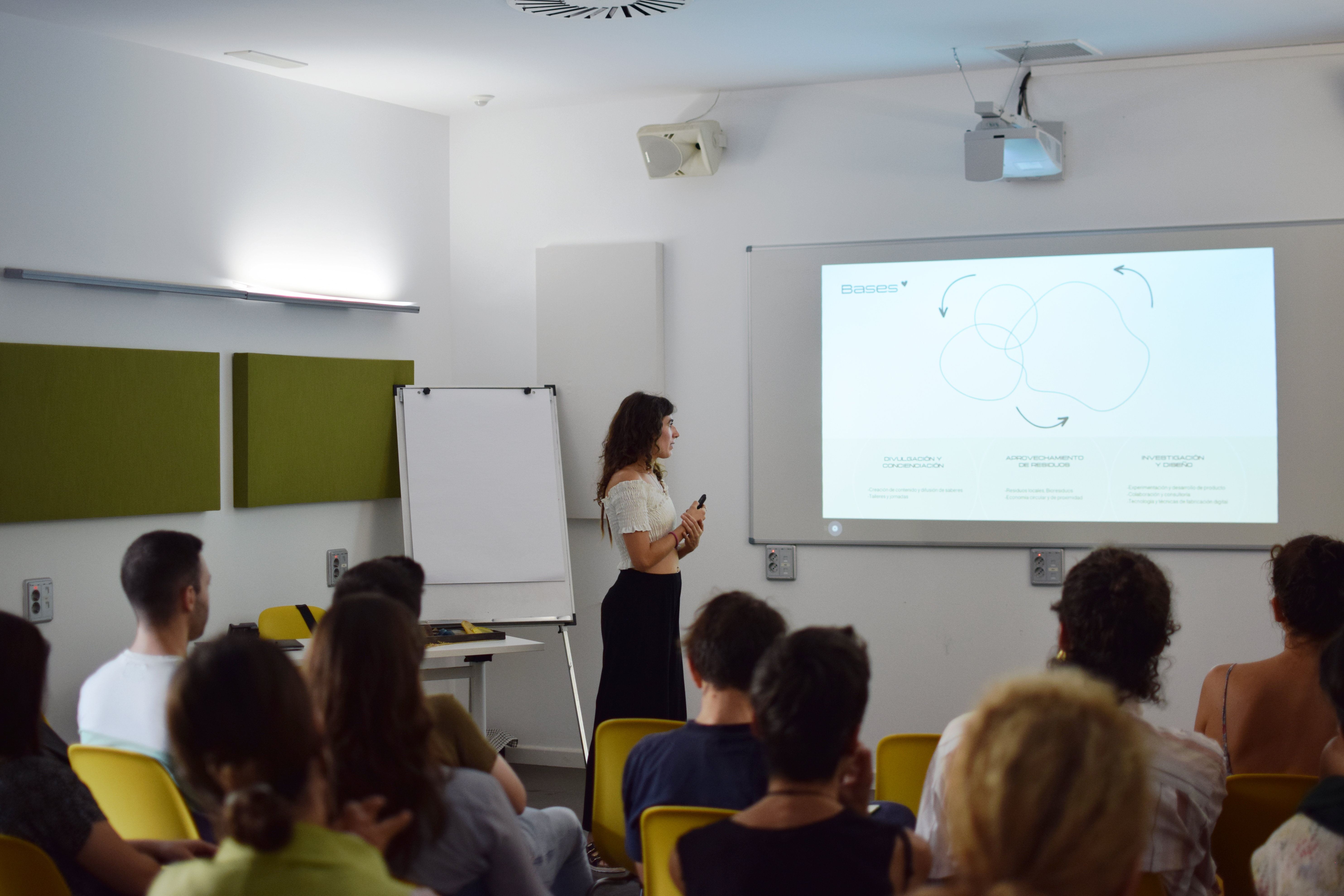Shaping a circular industrial ecosystem and supporting life-cycle thinking
Designing New Futures with Biomaterials
SIROPE LAB: Designing New Futures with Biomaterials and Digital Manufacturing.
Sirope Lab: "Designing New Futures with Biomaterials" explores the revaluation of agri-food waste into biomaterials through digital fabrication. Based in València, it integrates science, art, and ecology, using local waste like orange peels and mussel shells. Through workshops and collaborations, the project promotes biomaterials as a circular economy alternative, ensuring solutions are not only feasible but also culturally and economically sustainable.
Spain
Local
València city in particular and also Castellón and Alicante.
Mainly urban
It refers to other types of transformations (soft investment)
Yes
2024-11-30
Yes
European Solidarity Corps 2023
No
No
As a representative of an organisation
Sirope Lab presents a research and dissemination project that explores the revaluation of agri-food waste through the development of biomaterials and digital fabrication. In collaboration with designers, producers, local community and universities, the project integrates science, art and ecology in design, aligning with the values of the New European Bauhaus: circularity, inclusiveness and aesthetics.
The environmental crisis and the overexploitation of resources require a transformation in production processes. This project responds to the urgency of rethinking the materials we use, reducing the environmental impact of design. Based in València, a city surrounded by orchards and the sea, local waste such as orange peel, clotxina (mussel) shells and local peanuts have been used and integrated into new material solutions. Digital manufacturing, such as 3D printing with bio-based filaments and laser cutting, has allowed these developments to be optimised and scaled up. The project has connected with the community through workshops, applied research and interdisciplinary collaborations, promoting the use of biomaterials as a tangible alternative within the circular economy. These actions not only raise awareness of the potential of waste, but also show how local resources can be re-used.
We believe that innovation in biomaterials and digital fabrication can only generate real impact if it is collectively understood and embraced. The involvement of designers, producers and citizens ensures that these solutions are not only technically feasible, but also culturally relevant and economically sustainable in the long term.
The environmental crisis and the overexploitation of resources require a transformation in production processes. This project responds to the urgency of rethinking the materials we use, reducing the environmental impact of design. Based in València, a city surrounded by orchards and the sea, local waste such as orange peel, clotxina (mussel) shells and local peanuts have been used and integrated into new material solutions. Digital manufacturing, such as 3D printing with bio-based filaments and laser cutting, has allowed these developments to be optimised and scaled up. The project has connected with the community through workshops, applied research and interdisciplinary collaborations, promoting the use of biomaterials as a tangible alternative within the circular economy. These actions not only raise awareness of the potential of waste, but also show how local resources can be re-used.
We believe that innovation in biomaterials and digital fabrication can only generate real impact if it is collectively understood and embraced. The involvement of designers, producers and citizens ensures that these solutions are not only technically feasible, but also culturally relevant and economically sustainable in the long term.
Biomaterials
Outreach and community participation
Digital manufacturing
Waste revalorization
Sustainable design
The project approaches sustainability from a holistic perspective, promoting the transition towards a more regenerative and circular production system. It is committed to practical and local sustainability, exploring new ways of making the most of the resources we already have around us. Through research and development of biomaterials, we seek new possibilities in local waste, transforming it into valuable materials and rethinking our relationship with what we throw away.
We can highlight two main objectives:
1. Regenerative materiality: giving new life to local waste. We collaborate with farmers, producers and other waste generators (such as gastronomic spaces or community centres) to recover by-products that would otherwise go to waste. Orange peels, pruning waste, eggshells and coffee grounds are some of the materials we have worked with, exploring their potential to become new biomaterials with functional and expressive applications. In addition, digital manufacturing allows us to produce with low impact and maximise the use of resources and materials.
2. Education and outreach as tools for change
Sustainability is not only a question of materials, but also of shared knowledge. That is why we combine research with outreach, creating learning spaces where designers, students and communities can discover the potential of biomaterials. Through workshops and meetings, we have brought these processes closer to more people, opening conversations about responsibility in design and the need to move towards new models of production and consumption.
Beyond materials, the project seeks to generate questions and encourage a more conscious look at the life cycles of resources. We believe that sustainability is not only about finding alternatives, but also about changing the way we relate to what surrounds us.
We can highlight two main objectives:
1. Regenerative materiality: giving new life to local waste. We collaborate with farmers, producers and other waste generators (such as gastronomic spaces or community centres) to recover by-products that would otherwise go to waste. Orange peels, pruning waste, eggshells and coffee grounds are some of the materials we have worked with, exploring their potential to become new biomaterials with functional and expressive applications. In addition, digital manufacturing allows us to produce with low impact and maximise the use of resources and materials.
2. Education and outreach as tools for change
Sustainability is not only a question of materials, but also of shared knowledge. That is why we combine research with outreach, creating learning spaces where designers, students and communities can discover the potential of biomaterials. Through workshops and meetings, we have brought these processes closer to more people, opening conversations about responsibility in design and the need to move towards new models of production and consumption.
Beyond materials, the project seeks to generate questions and encourage a more conscious look at the life cycles of resources. We believe that sustainability is not only about finding alternatives, but also about changing the way we relate to what surrounds us.
The project not only seeks material alternatives, but also reimagines their aesthetic and cultural value. We believe that the perception of a material influences how its value, use and impact is understood. Through design and artistic exploration, we work to make biomaterials functional, expressive, sensorial and also capable of generating new narratives around waste and its transformative potential.
We have applied our biomaterials in multiple contexts, ranging from functional pieces to artistic interventions, demonstrating their versatility and symbolic charge. Some examples include:
The cover of the Green Book of València (European Green Capital 2024), in which a biomaterial made from orange peel becomes the skin of a publication that reflects on the ecological future of the city.
Award trophy made from agri-food waste and 3D printing, where the materials not only build the object, but also tell its story.
Interventions in gastronomic experiences, such as our collaboration in Oda a la Calabaza, where biomaterials are integrated into a space that celebrates food culture from an experimental and critical approach.
Each of these applications seeks to expand the perception of the material and connect with people in a deeper way. We are interested in seeing biomaterials not only as technical solutions, but as elements that generate experiences, awaken questions and bring new sensibilities to the relationship we have with objects and resources.
From this perspective, the project becomes a bridge between design, art and ecology, fostering a dialogue in which materials are not just tools, but stories in themselves with a symbolic and aesthetic value as well.
We have applied our biomaterials in multiple contexts, ranging from functional pieces to artistic interventions, demonstrating their versatility and symbolic charge. Some examples include:
The cover of the Green Book of València (European Green Capital 2024), in which a biomaterial made from orange peel becomes the skin of a publication that reflects on the ecological future of the city.
Award trophy made from agri-food waste and 3D printing, where the materials not only build the object, but also tell its story.
Interventions in gastronomic experiences, such as our collaboration in Oda a la Calabaza, where biomaterials are integrated into a space that celebrates food culture from an experimental and critical approach.
Each of these applications seeks to expand the perception of the material and connect with people in a deeper way. We are interested in seeing biomaterials not only as technical solutions, but as elements that generate experiences, awaken questions and bring new sensibilities to the relationship we have with objects and resources.
From this perspective, the project becomes a bridge between design, art and ecology, fostering a dialogue in which materials are not just tools, but stories in themselves with a symbolic and aesthetic value as well.
The project understands sustainability as a process that can only be effective if it is accessible and inclusive. Therefore, we work at the intersection between design, education and community, creating open spaces where anyone, regardless of their previous training, can approach the world of biomaterials and waste transformation.
Through workshops, meetings and collaborations, we have involved young people, students, designers, local producers and diverse collectives, bringing tools and knowledge that have traditionally been restricted to certain sectors. We believe that sharing these processes and making them understandable is key to making new material ecologies an adopted reality and not just a distant concept.
We are interested in ensuring that innovation does not depend on large infrastructures or inaccessible investments, but that it can be integrated into the daily lives of different agents. Therefore, we work with local resources, we encourage the use of affordable technologies such as digital fabrication in shared spaces, and we promote decentralised production models where each community can adapt and develop their own materials according to their context.
This approach has allowed us to bring the exploration of biomaterials to a wide range of educational and social contexts, from universities to community spaces, ensuring that access to knowledge and experimentation is not limited by economic or educational barriers. Our aim is to make materials design a real and accessible tool for transformation, contributing to a future in which innovation is not only sustainable, but also collective and accessible.
Through workshops, meetings and collaborations, we have involved young people, students, designers, local producers and diverse collectives, bringing tools and knowledge that have traditionally been restricted to certain sectors. We believe that sharing these processes and making them understandable is key to making new material ecologies an adopted reality and not just a distant concept.
We are interested in ensuring that innovation does not depend on large infrastructures or inaccessible investments, but that it can be integrated into the daily lives of different agents. Therefore, we work with local resources, we encourage the use of affordable technologies such as digital fabrication in shared spaces, and we promote decentralised production models where each community can adapt and develop their own materials according to their context.
This approach has allowed us to bring the exploration of biomaterials to a wide range of educational and social contexts, from universities to community spaces, ensuring that access to knowledge and experimentation is not limited by economic or educational barriers. Our aim is to make materials design a real and accessible tool for transformation, contributing to a future in which innovation is not only sustainable, but also collective and accessible.
The project has involved citizens, designers, artists and producers in a process of collective learning and experimentation, strengthening interdisciplinary networks. Their participation has been key at different levels:
- Citizens and general public: they have been part of workshops and outreach activities, gaining awareness of the environmental impact of conventional materials and exploring new alternatives.
- Professionals from design, art and other disciplines: they have not only participated in workshops, but have also applied their technical and creative knowledge in the exploration of new uses for biomaterials, generating synergies and interdisciplinary collaborations.
- Waste producers and generators: have contributed raw materials and actively participated in the research process, understanding how their waste can be converted into materials with functional and aesthetic value.
The interaction between these groups has fostered an ecosystem of learning and collaboration, promoting the integration of biomaterials in different fields. Through workshops and meetings, participants have acquired tools to question current production models and explore more responsible approaches.
In addition, this process has brought together sectors that have not traditionally shared spaces for exchange, facilitating the development of new applications for biomaterials. The community has not only been a recipient of knowledge, but has also participated in the co-creation of solutions, contributing local knowledge and expanding the possibilities for the application of these materials in different contexts.
- Citizens and general public: they have been part of workshops and outreach activities, gaining awareness of the environmental impact of conventional materials and exploring new alternatives.
- Professionals from design, art and other disciplines: they have not only participated in workshops, but have also applied their technical and creative knowledge in the exploration of new uses for biomaterials, generating synergies and interdisciplinary collaborations.
- Waste producers and generators: have contributed raw materials and actively participated in the research process, understanding how their waste can be converted into materials with functional and aesthetic value.
The interaction between these groups has fostered an ecosystem of learning and collaboration, promoting the integration of biomaterials in different fields. Through workshops and meetings, participants have acquired tools to question current production models and explore more responsible approaches.
In addition, this process has brought together sectors that have not traditionally shared spaces for exchange, facilitating the development of new applications for biomaterials. The community has not only been a recipient of knowledge, but has also participated in the co-creation of solutions, contributing local knowledge and expanding the possibilities for the application of these materials in different contexts.
The project has engaged actors at multiple levels, creating a collaborative network around biomaterials and their role in redefining waste and material production.
Local level, we have worked with farmers and agri-food producers like CA Climent to explore how their crop residues (such as peanut shells) can be transformed into new materials. We also collaborate with local businesses, such as the Amor Amargo winery and the Consum supermarket, collecting discarded orange peel and other food waste for research. Through open workshops in cultural and educational spaces, we engage the community in discussions about material use and disposal.
Regional level, we have established partnerships with universities like UPV and CEU, introducing biomaterials into the training of design and engineering students through workshops. We have also participated in events such as Valencia Disseny Week and FIC Festival, demonstrating the application of biomaterials in design, architecture, and artistic practices.
National level, we have collaborated on projects that promote the circular economy, including the Green Book of Valencia European Green Capital 2024, for which we developed a biomaterial cover from orange peel. Additionally, we designed the KMZERO Awards trophies using agri-food waste and 3D printing, expanding the visibility of biomaterials in new formats.
European level, we have worked with scientists, artists and designers exploring biomaterials in creative projects. We developed laser-engraved bioplastic pieces for Delphine Lejeune, exhibited in Estonia, and participated in the Future Materials Exhibition at MoMe University in Hungary, showcasing our research among leading biomaterial innovations. Our work has been shared in international platforms and networks, facilitating knowledge exchange within the biomaterials field.
Local level, we have worked with farmers and agri-food producers like CA Climent to explore how their crop residues (such as peanut shells) can be transformed into new materials. We also collaborate with local businesses, such as the Amor Amargo winery and the Consum supermarket, collecting discarded orange peel and other food waste for research. Through open workshops in cultural and educational spaces, we engage the community in discussions about material use and disposal.
Regional level, we have established partnerships with universities like UPV and CEU, introducing biomaterials into the training of design and engineering students through workshops. We have also participated in events such as Valencia Disseny Week and FIC Festival, demonstrating the application of biomaterials in design, architecture, and artistic practices.
National level, we have collaborated on projects that promote the circular economy, including the Green Book of Valencia European Green Capital 2024, for which we developed a biomaterial cover from orange peel. Additionally, we designed the KMZERO Awards trophies using agri-food waste and 3D printing, expanding the visibility of biomaterials in new formats.
European level, we have worked with scientists, artists and designers exploring biomaterials in creative projects. We developed laser-engraved bioplastic pieces for Delphine Lejeune, exhibited in Estonia, and participated in the Future Materials Exhibition at MoMe University in Hungary, showcasing our research among leading biomaterial innovations. Our work has been shared in international platforms and networks, facilitating knowledge exchange within the biomaterials field.
The project has brought together different disciplines and fields of knowledge, connecting science, design and art to rethink the use of materials and their impact on our environment.
Materials science and biotechnology: through experimentation with biomaterials, we have investigated how to transform agri-food waste into new functional materials. Collaborations with biotechnology experts have allowed us to better understand their properties and application possibilities.
Digital design and manufacturing: the use of tools such as 3D printing, laser engraving or moulding has allowed us to adapt these materials to new shapes and applications. Designers and makers have explored how these processes can lead to creative and accessible solutions.
Art and visual narratives: the project has also been a space for artistic exploration, using biomaterials not only for their functionality, but also as a means to reflect on the relationship between matter, production and territory. Pieces have been developed that integrate textures, translucencies and new finishes that broaden the sensory perception of these materials.
Ecology and circular economy: working with local farmers and producers has made it possible to generate a direct link between the waste generated in the territory and its transformation into resources. This connection has been key to demonstrating that circularity is possible through accessible and decentralised processes.
The value of this approach has been the interaction between disciplines, where technical knowledge has combined with creativity to generate new possibilities. Scientists and designers have worked together to test and optimise materials, while artists and creators have contributed new insights into their application. This collective process has allowed the project not only to advance in terms of research, but also to promote new forms of production that are closer, more accessible and more committed to their environment.
Materials science and biotechnology: through experimentation with biomaterials, we have investigated how to transform agri-food waste into new functional materials. Collaborations with biotechnology experts have allowed us to better understand their properties and application possibilities.
Digital design and manufacturing: the use of tools such as 3D printing, laser engraving or moulding has allowed us to adapt these materials to new shapes and applications. Designers and makers have explored how these processes can lead to creative and accessible solutions.
Art and visual narratives: the project has also been a space for artistic exploration, using biomaterials not only for their functionality, but also as a means to reflect on the relationship between matter, production and territory. Pieces have been developed that integrate textures, translucencies and new finishes that broaden the sensory perception of these materials.
Ecology and circular economy: working with local farmers and producers has made it possible to generate a direct link between the waste generated in the territory and its transformation into resources. This connection has been key to demonstrating that circularity is possible through accessible and decentralised processes.
The value of this approach has been the interaction between disciplines, where technical knowledge has combined with creativity to generate new possibilities. Scientists and designers have worked together to test and optimise materials, while artists and creators have contributed new insights into their application. This collective process has allowed the project not only to advance in terms of research, but also to promote new forms of production that are closer, more accessible and more committed to their environment.
The innovative approach is the common thread that unites research in biomaterials, digital fabrication and educational outreach, creating new connections between design, science and territory. Unlike conventional models of materials production, based on non-renewable resources and polluting industrial processes, we explore how to transform local waste into new materials applicable to design and creation.
The project moves away from the extractivist logic and proposes a more decentralised, accessible and experimental system, in which biomaterials are developed in relation to their context and available waste. We do not seek to replicate industrial processes, but to rethink the way we produce and use materials, adapting to what the environment already provides us with.
In contrast to the more closed research in other technical environments, Sirope Lab is committed to openness and collaboration. We work with designers, artists, agri-food producers and citizens, generating interdisciplinary networks that allow us not only to create new materials, but also to rethink their applications in product design, artistic installations or digital fabrication.
Another key element is dissemination and participation. Instead of limiting knowledge of biomaterials to the scientific or academic community, we bring it closer to different audiences through workshops and open meetings, where anyone can experiment with these materials and reflect on their impact.
In short, this project not only investigates new ways of making materials, but also generates a different narrative about resources, consumption and production, demonstrating that another model of relationship with matter is possible.
The project moves away from the extractivist logic and proposes a more decentralised, accessible and experimental system, in which biomaterials are developed in relation to their context and available waste. We do not seek to replicate industrial processes, but to rethink the way we produce and use materials, adapting to what the environment already provides us with.
In contrast to the more closed research in other technical environments, Sirope Lab is committed to openness and collaboration. We work with designers, artists, agri-food producers and citizens, generating interdisciplinary networks that allow us not only to create new materials, but also to rethink their applications in product design, artistic installations or digital fabrication.
Another key element is dissemination and participation. Instead of limiting knowledge of biomaterials to the scientific or academic community, we bring it closer to different audiences through workshops and open meetings, where anyone can experiment with these materials and reflect on their impact.
In short, this project not only investigates new ways of making materials, but also generates a different narrative about resources, consumption and production, demonstrating that another model of relationship with matter is possible.
The project combines research, digital fabrication and community participation to explore new forms of material production based on the revalorisation of waste and experimentation with biomaterials. Its development is structured in several interconnected phases:
-Applied research: we explore different agri-food waste to assess their viability as biomaterials, experimenting with their properties and possible applications. We seek to understand how to transform them into new functional and expressive materials. We start the research work on a specific waste in three different ways: demand from the producer, search for a second life for a specific waste, or because of an environmental problem produced by a type of waste.
-Digital fabrication: tools such as 3D printing with bio-based filaments, laser cutting and thermoforming allow us to manipulate biomaterials in a more precise and versatile way, opening up new design possibilities without generating large amounts of waste.
-Interdisciplinary collaboration: designers, artists, agri-food producers and scientists work together to expand the applications of biomaterials and generate shared knowledge. We have networked with universities, innovation centres and local agents, which has enriched the project and multiplied its impact.
-Education and dissemination: through open workshops, talks and meetings, we bring knowledge about biomaterials to different audiences, encouraging exploration and reflection on new forms of production and consumption.
Unlike industrial methodologies that seek standardisation and scalability, this project is based on adaptation and community experimentation. There are no single solutions, but multiple paths to be discovered based on the resources and needs of each context.
-Applied research: we explore different agri-food waste to assess their viability as biomaterials, experimenting with their properties and possible applications. We seek to understand how to transform them into new functional and expressive materials. We start the research work on a specific waste in three different ways: demand from the producer, search for a second life for a specific waste, or because of an environmental problem produced by a type of waste.
-Digital fabrication: tools such as 3D printing with bio-based filaments, laser cutting and thermoforming allow us to manipulate biomaterials in a more precise and versatile way, opening up new design possibilities without generating large amounts of waste.
-Interdisciplinary collaboration: designers, artists, agri-food producers and scientists work together to expand the applications of biomaterials and generate shared knowledge. We have networked with universities, innovation centres and local agents, which has enriched the project and multiplied its impact.
-Education and dissemination: through open workshops, talks and meetings, we bring knowledge about biomaterials to different audiences, encouraging exploration and reflection on new forms of production and consumption.
Unlike industrial methodologies that seek standardisation and scalability, this project is based on adaptation and community experimentation. There are no single solutions, but multiple paths to be discovered based on the resources and needs of each context.
The project offers a model adaptable to different territories and communities, based on the revaluation of local waste and the exploration of biomaterials. We do not propose a single closed solution, but a flexible approach that allows adapting methodologies according to the resources, needs and knowledge of each context.
-Exploration of biomaterials from local waste: our research approach can be transferred to any region, using agri-food waste specific to each territory to generate materials with their own identity.
-Open and collaborative processes: the combination of digital fabrication and artisanal techniques allows the development of biomaterials to be accessible to different profiles.
-Educational and informative methodologies: the workshops and activities we have developed can be implemented in other environments, facilitating understanding and experimentation with biomaterials in universities, art centers and community spaces.
Intersection between disciplines: the collaboration with designers, artists, researchers and farmers demonstrates that these materials can be applied in different fields, from art to the design of everyday objects.
In addition to being able to replicate a technical process, the value of the project lies in its ability to open up new questions and paths, encouraging critical thinking about materials and production. This makes it a powerful tool to generate impact in diverse contexts, driving the transition towards more responsible and creative systems.
-Exploration of biomaterials from local waste: our research approach can be transferred to any region, using agri-food waste specific to each territory to generate materials with their own identity.
-Open and collaborative processes: the combination of digital fabrication and artisanal techniques allows the development of biomaterials to be accessible to different profiles.
-Educational and informative methodologies: the workshops and activities we have developed can be implemented in other environments, facilitating understanding and experimentation with biomaterials in universities, art centers and community spaces.
Intersection between disciplines: the collaboration with designers, artists, researchers and farmers demonstrates that these materials can be applied in different fields, from art to the design of everyday objects.
In addition to being able to replicate a technical process, the value of the project lies in its ability to open up new questions and paths, encouraging critical thinking about materials and production. This makes it a powerful tool to generate impact in diverse contexts, driving the transition towards more responsible and creative systems.
Responds to environmental and production problems on a global scale, proposing solutions from a local and situated approach. Through the development of biomaterials, we seek to question linear consumption systems and explore forms of production that are more responsible and connected to the territory.
The waste crisis and plastic pollution. Transforming agri-food waste into biomaterials, reducing the amount of waste generated and offering alternatives to conventional materials. We collaborate with farmers, restaurants and local producers to take advantage of discarded resources, such as orange peels or coffee waste.
The disconnection between production and territory. Relying on raw materials from the Valencian orchard, promoting the use of nearby resources and fostering the circular economy. Instead of importing standardized solutions, we explore how each context can generate its own materials, connecting innovation with local identity.
Lack of access to knowledge about emerging materials. Developing workshops and educational experiences that allow students, designers and communities to experiment with biomaterials in an accessible way. These activities have been implemented in universities, cultural spaces and festivals, democratizing access to new practices.
Lack of synergies between science, design and community. We encourage collaboration between disciplines, creating bridges between designers, scientists, artists and producers. This interdisciplinary approach allows us not only to generate new materials, but also to reimagine the way they are produced and consumed in different spheres.
Beyond the tangible results, the project proposes a way of thinking and doing that can be applied anywhere, adapting to the resources and needs of each community. In the face of global challenges, we believe in locally rooted solutions, designed with awareness and purpose.
The waste crisis and plastic pollution. Transforming agri-food waste into biomaterials, reducing the amount of waste generated and offering alternatives to conventional materials. We collaborate with farmers, restaurants and local producers to take advantage of discarded resources, such as orange peels or coffee waste.
The disconnection between production and territory. Relying on raw materials from the Valencian orchard, promoting the use of nearby resources and fostering the circular economy. Instead of importing standardized solutions, we explore how each context can generate its own materials, connecting innovation with local identity.
Lack of access to knowledge about emerging materials. Developing workshops and educational experiences that allow students, designers and communities to experiment with biomaterials in an accessible way. These activities have been implemented in universities, cultural spaces and festivals, democratizing access to new practices.
Lack of synergies between science, design and community. We encourage collaboration between disciplines, creating bridges between designers, scientists, artists and producers. This interdisciplinary approach allows us not only to generate new materials, but also to reimagine the way they are produced and consumed in different spheres.
Beyond the tangible results, the project proposes a way of thinking and doing that can be applied anywhere, adapting to the resources and needs of each community. In the face of global challenges, we believe in locally rooted solutions, designed with awareness and purpose.
The project has achieved both tangible and intangible results, advancing biomaterial experimentation and raising awareness on responsible consumption and production.
Biomaterial development. We have created materials from orange peels, coffee waste, eggshells, and other agro-food byproducts, applying them in projects such as the València Green Book cover, KMZERO Awards trophies, and artistic installations.
Waste repurposing. By transforming local agro-food waste, we have prevented 500 kg of organic material from being discarded, turning it into a valuable resource.
Prototyping and applications. The biomaterials have been tested in digital fabrication, including 3D printing and laser cutting, exploring their potential in product design, architecture, and visual communication.
Education and outreach. Through workshops and talks, we have introduced biomaterial research to students, professionals, and local communities, allowing them to experiment and engage with these materials firsthand.
Collaborations and impact. We have worked with artists, designers, and farmers to explore new material applications, strengthening the link between design and local production. The project has fostered a new vision of materials based on regeneration and circularity, creating a collaborative space for knowledge exchange.
This work highlights biomaterials as a viable and necessary alternative for a future that is more conscious and environmentally connected.
Biomaterial development. We have created materials from orange peels, coffee waste, eggshells, and other agro-food byproducts, applying them in projects such as the València Green Book cover, KMZERO Awards trophies, and artistic installations.
Waste repurposing. By transforming local agro-food waste, we have prevented 500 kg of organic material from being discarded, turning it into a valuable resource.
Prototyping and applications. The biomaterials have been tested in digital fabrication, including 3D printing and laser cutting, exploring their potential in product design, architecture, and visual communication.
Education and outreach. Through workshops and talks, we have introduced biomaterial research to students, professionals, and local communities, allowing them to experiment and engage with these materials firsthand.
Collaborations and impact. We have worked with artists, designers, and farmers to explore new material applications, strengthening the link between design and local production. The project has fostered a new vision of materials based on regeneration and circularity, creating a collaborative space for knowledge exchange.
This work highlights biomaterials as a viable and necessary alternative for a future that is more conscious and environmentally connected.

